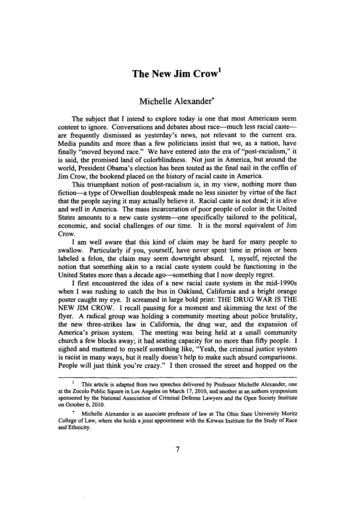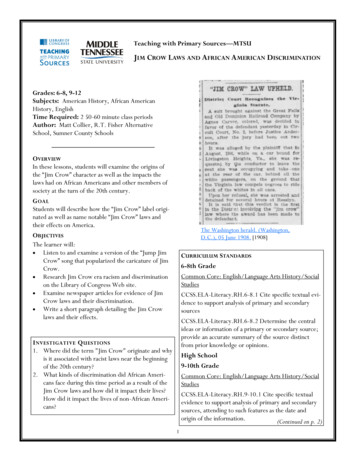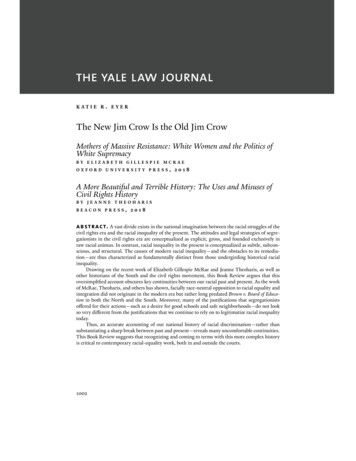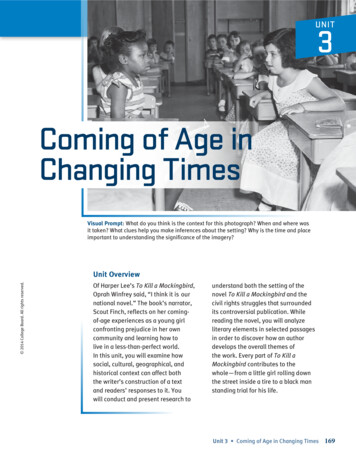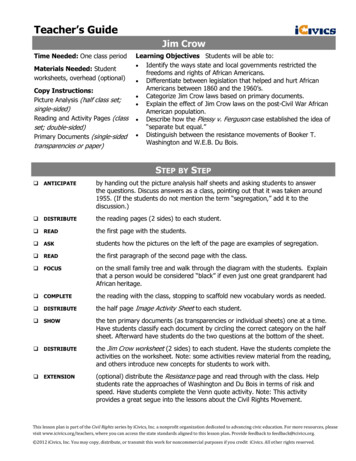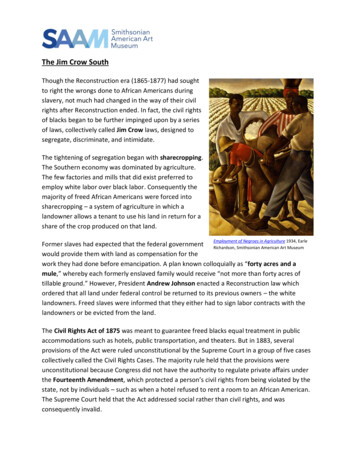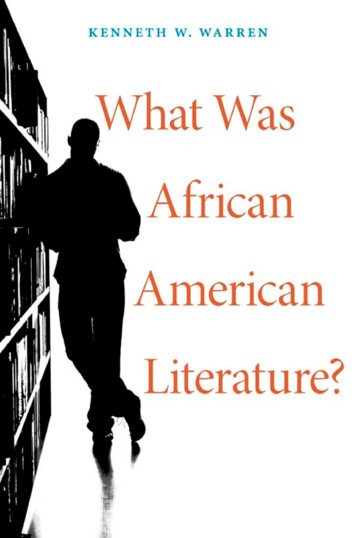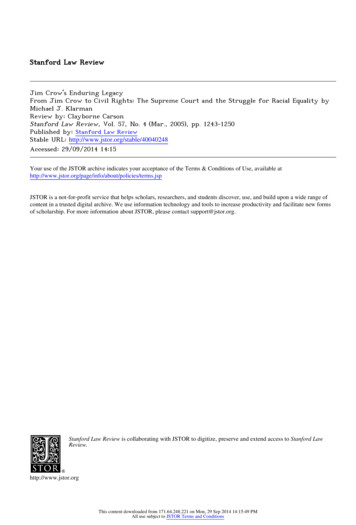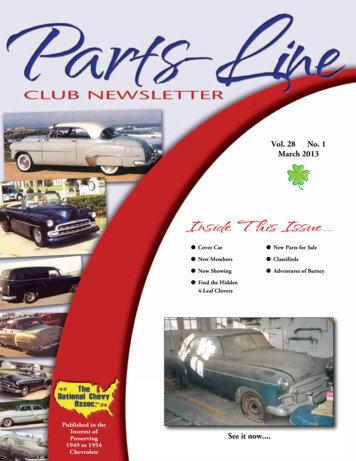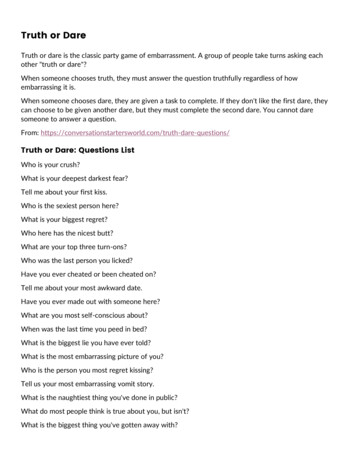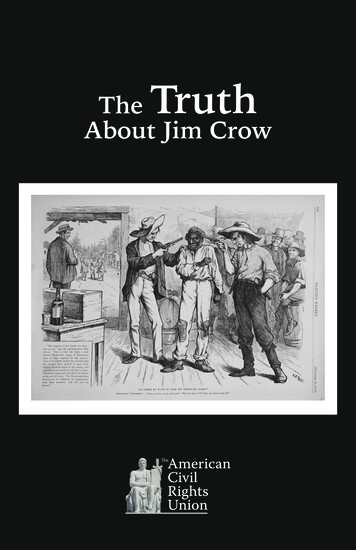
Transcription
TruthTheAbout Jim Crow
IntroductionThe Jim Crow era ended nearly 50 years ago with the passage of the 1965Voting Rights Act, which restored African-Americans to full citizenship inthe United States after a century of legalized oppression. As the era fadesdeeper and deeper into the past, Americans are rapidly forgetting thehistorical realities of Jim Crow. Most of us weren’t even born when JimCrow mercifully came to an end. Therefore, most of us never personallyexperienced one of the ugliest and most shameful chapters in Americanhistory.Jim Crow was an era in which whites, mostly but not always in the South,used methods sometimes legal, sometimes illegal, often deadly, but alwaysimmoral, to maintain political and cultural domination over blacks. Blackswere reduced to second-class citizenship. They were denied the right tovote, kept separate from whites in most phases of life, and in general,treated as if they were subhuman, in an effort to justify white supremacyand keep the black population under tight control.This brief paper is not intended to be an exhaustive academic treatiseabout the Jim Crow era. Instead, its purpose is to reacquaint readers withthe most important aspects of Jim Crow, by addressing the Jim Crow era’swhite supremacist culture, how white supremacy was enforced, and thepolitics of the era. The public should come away understanding the threemost important facts about Jim Crow: Jim Crow was Dehumanizing; JimCrow was Deadly; and Jim Crow was Democratic.Copyright 2014 The American Civil Rights Union1
I. Jim Crow wasDehumanizing:The Culture of Jim CrowJim Crow was an entire way of life dedicated to asserting and maintainingthe superiority of whites over blacks. The Jim Crow system dominated thesouthern and border states, though Jim Crow laws and attitudes could befound in the Northeast, the Midwest and the West as well. In the South,blacks were systematically oppressed and deprived of their constitutionalrights, and strict segregation of the races was aggressively enforced. Socialinstitutions were structured to reinforce the organizing principle of theculture: that blacks were inherently inferior to whites, in effect subhuman.In consequence, blacks and whites were never supposed to relate to oneanother as equals. The principle of black inferiority pervaded every aspectof life, from status before the law to the voting franchise, from educationto access to public accommodations to entertainment and even to socialetiquette.Jim Crow’s Historical SettingFor all practical purposes, the Civil War ended with Confederatecommander Robert E. Lee’s surrender on April 9, 1865. Slavery endedin practice on June 19, 1865, when the Union Army reached Galvestonand ordered the freeing of the 200,000 slaves in Texas. As the postwarReconstruction period (1865–1877) began, Federal forces occupied theSouth. Blacks began to organize politically and campaign for equal legaland political status as early as 1865, forming equal rights movementsthroughout the South. The 13th Amendment to the Constitution ratified onDecember 18, 1865, banished slavery in the United States.Copyright 2014 The American Civil Rights Union3
Following Republican Abraham Lincoln’s assassination, however, hissuccessor, Democratic President Andrew Johnson, allowed Southern statesto implement “black codes,” which restricted and controlled the newlyfreed slaves. The political tide turned with Republican victory in the 1866Congressional elections. The Republicans fought to elevate the newlyemancipated black slaves to full citizenship, successfully engineering twomore constitutional amendments. The 14th Amendment, ratified on July28, 1868, extended equal protection of the laws to former slaves, and the15th Amendment, ratified on March 30, 1870, guaranteed that all blacks,including former slaves, had the right to vote.The cumulative effect of these constitutional amendments was to makeformer slaves fully equal American citizens in the eyes of the law. Becausemost Southern states had substantial black populations, black candidatesbegan to win state and local elections. The first black man to be seatedin the House of Representatives, Joseph Rainey of South Carolina, waselected in 1870. In the same year, Hiram Rhodes Revel of Mississippibecame the first black U. S. Senator. “In all, 16 African Americans servedin the U.S. Congress during Reconstruction; more than 600 more wereelected to the state legislatures, and hundreds more held local officesacross the South.”1 Everyone was a Republican.Blacks elected to the U.S. Congress in 1870 and 1872. Hiram Rhodes Revel is on thefar left, and Joseph Rainey is second from the right.4The Truth About Jim Crow
Backlash: the Beginning of Jim CrowGrowing black political power was viewed with hostility by whites, whohad ruled the roost until 1865. But even more threatening was the growthof black social status. As blacks began to interact more frequently andmore equally with whites, many whites feared that interracial marriagescould become commonplace, and “would produce a mongrel race whichwould destroy America.”2 The stereotype that black males were sexuallyuncontrollable and predatory was ubiquitous, such that many whitewomen feared being raped. To avoid these perceived dangers, manywhites felt social contacts between the races had to be kept to an absoluteminimum, and white political dominance had to be reestablished.The Reconstruction era ended with the Compromise of 1877, whichresolved the disputed 1876 presidential election. Democrats controlledthe House of Representatives, which gave them the power to preventthe inauguration of the new president. The Democrats agreed to allowRepublican Rutherford B. Hayes to enter the White House in return forthe withdrawal of the Federal troops still occupying the South. The troopswere the principal guardians of the safety of the Republican governmentsin Southern states, and when they departed, many white Republicans leftthe South as well.The South was left in the hands of the Democratic Party, whichconsidered itself the “party of the white man.”3 Democrats establishedso-called “redeemer governments” throughout the region, and began toreassert white supremacy by passing laws that infringed upon the rights ofblacks and enforced strict segregation.Black legal and political rights quickly deteriorated. “[A]fter 1877, most lostthe right to vote or to hold government positions.”4 The 1875 Civil RightsAct, which banned discrimination based on race, was overturned by theU.S. Supreme Court in 1883.In 1890, the Louisiana General Assembly passed a law requiringsegregated railroad cars. In 1896, this legalized segregation was upheldby the U.S. Supreme Court in the Plessy v. Ferguson case. In itsinfamous Plessy decision, the Court established the principle that publicaccommodations could be “separate but equal.” In 1898, the SupremeCourt went further in its Williams v. Mississippi decision, upholding aMississippi law intended to prevent blacks from voting.Once discriminatory laws were approved in principle by the SupremeCourt, such laws spread quickly throughout the South. According to theCivil Rights Foundation, “Given the green light, Southern states began tolimit the voting right to those who owned property or could read well,Copyright 2014 The American Civil Rights Union5
to those whose grandfathers had been able to vote, to those with ‘goodcharacters,’ to those who paid poll taxes. In 1896, Louisiana had 130,334registered black voters. Eight years later, only 1,342, one percent, couldpass the state’s new rules.5SegregationRacial segregation was the very heart of Jim Crow, and the Jim Crow erawas marked by the adoption of explicitly racist laws intended to keepblacks and whites away from each other everywhere from ballparks tograveyards. Black access to public accommodations like restaurants,buses and trains was restricted, and blacks were forced into separate (andinferior) schools. Laws decreed segregation in areas ranging from theprofound to the petty, as the following list illustrates6:Amateur Baseball: “It shall be unlawful for any amateur whitebaseball team to play baseball on any vacant lot or baseball diamondwithin two blocks of a playground devoted to the Negro race, andit shall be unlawful for any amateur colored baseball team to playbaseball in any vacant lot or baseball diamond within two blocks ofany playground devoted to the white race.” (Georgia law)Barbering: “No colored person shall serve as a barber [to] whitewomen or girls.” (Georgia law)Beer and Wine Sales: “All persons licensed to conduct the businessof selling beer or wine.shall serve either white people exclusively orcolored people exclusively and shall not sell to two races within thesame room at any time.” (Georgia law)Burial: “The officer in charge shall not bury, or allow to be buried,any colored persons upon ground set apart or used for the burial ofwhite persons.” (Georgia law)Buses: “All passenger stations in this state operated by any motortransportation company shall have separate waiting rooms or spaceand separate ticket windows for the white and colored races.”(Alabama law)Hospitalization: “The Board of Control shall see that properand distinct apartments are arranged for said patients [in a mentalhospital], so that in no cases shall Negroes and white persons betogether.” (Georgia law)Libraries: “The state librarian is directed to fit up and maintain aseparate place for the use of the colored people who may come to6The Truth About Jim Crow
the library for the purpose of reading books or periodicals.” (NorthCarolina law)Marriage: “All marriages between a white person and a negro, orbetween a white person and a person of negro descent to the fourthgeneration inclusive, are hereby forever prohibited.” (Florida law)Marriage: “All marriages of white persons with Negroes, Mulattos,Mongolians, or Malaya hereafter contracted in the State of Wyomingare and shall be illegal and void.” (Wyoming law)Nursing: “No person or corporation shall require any White femalenurse to nurse in wards or rooms in hospitals, either public or private,in which negro men are placed.” (Alabama law)Prison: “The warden shall see that the white convicts shall haveseparate apartments for both eating and sleeping from the negroconvicts.” (Mississippi law)Restaurants: “It shall be unlawful to conduct a restaurant or otherplace for the serving of food in the city, at which white and coloredpeople are served in the same room, unless such white and coloredpersons are effectually separated by a solid partition extending fromthe floor upward to a distance of seven feet or higher, and unless aseparate entrance from the street is provided for each compartment.”(Alabama law)Schools: “Separate rooms [shall] be provided for the teaching ofpupils of African descent, and [when] said rooms are provided, suchpupils may not be admitted to the school rooms occupied and usedby pupils of Caucasian or other descent.” (New Mexico law)Schools: “[The County Board of Education] shall provide schools oftwo kinds; those for white children and those for colored children.”(Texas law)Teaching: “Any instructor who shall teach in any school, collegeor institution where members of the white and colored races arereceived and enrolled as pupils for instruction shall be deemed guiltyof a misdemeanor, and upon conviction thereof, shall be fined.”(Oklahoma law)Toilets: “Every employer of white or negro males shall provide forsuch white or negro males reasonably accessible and separate toiletfacilities.” (Alabama law)Copyright 2014 The American Civil Rights Union7
Voter DenialKeeping blacks out of the polling booth was essential for maintainingwhite political dominance. Blacks were denied the franchise in manyways. Dr. Russell Booker of America’s Black Holocaust Museum hasidentified eight methods used to deny blacks the right to vote7:All-white primary elections: In the United States, there are usuallytwo rounds of elections: first the primary, then the general. Inthe primary, Republicans run against Republicans and Democratsrun against Democrats. In the general election, the winner of theRepublican primary runs against the winner of the Democraticprimary. The Republican or Democrat who gets the most votes iselected.In the South from about 1900 to about 1960, the Democraticcandidates usually won. (See the exhibit Political Parties in Black andWhite to learn the reason for this.) Republicans were almost neverelected, especially in the Deep South. This means that the Democraticprimary election was usually the only election that mattered.African Americans were not allowed to vote in the Democraticprimary elections. White Democrats said the Democratic Party was a“club” and did not allow black members. So blacks could not vote inthe only elections that mattered.Former prisoners: People who had gone to prison were often notallowed to vote. Blacks were very often arrested on trumped-upcharges or for minor offenses. Sometimes, white owners of mines,farms, and factories simply needed cheap labor, and prisons providedit. This law kept many more blacks from voting than whites.Grandfather clause: People who could not read and owned noproperty were allowed to vote if their fathers or grandfathers hadvoted before 1867. Of course, practically no blacks could vote before1867, so the grandfather clause worked only for whites.Literacy tests: Today almost all adults can read. One hundred yearsago, however, many people – black and white – were illiterate. Mostilliterate people were not allowed to vote. A few were allowed ifthey could understand what was read to them. White officials usuallyclaimed that whites could understand what was read. They said blackscould not understand it, even if they could.8The Truth About Jim Crow
Poll taxes: In Southern states, people had to pay a tax to vote. Thetaxes were about 25 to 50 dollars in today’s money. Many peoplehad extremely low incomes and could not afford this tax. This poll taxapplied to all people who wanted to vote – black and white. Therewere ways for whites to get around other laws, but not around thepoll tax. Many poor whites could not vote because of the poll tax.(Others contend that grandfather clauses did, in some states, enablewhites whose fathers or grandfathers had voted before 1865 to beexcused from paying the poll tax.8)Property tests: In the South one hundred years ago, many statesallowed only property owners to vote. Many blacks and whites hadno property and could not vote.Purges: From time to time, white officials purged the voting rolls.That means they took people’s names off the official lists of voters.Some voters would arrive at the polls and find that they were notregistered to vote. Often they could not register to vote again untilafter the election. Purges more often affected blacks than whites.Violence: Blacks who tried to vote were threatened, beaten, andkilled. Their families were also harmed. Sometimes their homeswere burned down. Often, they lost their jobs or were thrown offtheir farms. Whites used violence to intimidate blacks and preventthem from even thinking about voting. Still, some blacks passed therequirements to vote and took the risk. Some whites used violenceto punish those “uppity” people and show other blacks what wouldhappen to them if they voted.According to the Veterans of the Civil Rights Movement, literacy tests oftenwent far beyond simple tests of literacy9:Prior to passage of the federal Voting Rights Act in 1965, Southern(and some Western) states maintained elaborate voter registrationprocedures whose primary purpose was to deny the vote tononwhites. This process was often referred to as a “literacy test.”[Editor’s note: in fact, many states, even states in the Northeast, hadliteracy tests.10] But in fact, it was much more than just a reading test, itwas an entire complex system devoted to denying African-Americans(and in some regions, Latinos and Native Americans) the right to vote.Veterans of the Civil Rights Movement went on to describe voterregistration in Alabama11:In Alabama, a typical registration process for an AfricanAmerican citizen went something like this:Copyright 2014 The American Civil Rights Union9
In the rural counties where most folks lived, you had to go downto the courthouse to register. The Registrar’s Office was only openevery other Monday for a couple of hours, usually in the morningor afternoon. You had to take off work — with or without youremployer’s permission — to register. And if a white employer gavesuch permission, or failed to fire a Black who tried to vote, he couldbe driven out of business by economic retaliation from the CitizensCouncil.On the occasional registration day, the county Sheriff and his deputiesmade it their business to hang around the courthouse to discourage“undesirables” from trying to register. This meant that Black womenand men had to run a gauntlet of intimidation, insults, threats, andsometimes arrest on phony charges, just to get to the RegistrationOffice. Once in the Registrar’s Office they faced hatred, harassment,and humiliation from clerks and officials.The Alabama Application Form and oaths you had to take were fourpages long. It was designed to intimidate and threaten. You had toswear that your answers to every single question were true underpenalty of perjury. And you knew that the information you entered onthe form would be passed on to the Citizens Council and KKK.Jim Crow’s Social EtiquetteDiscrimination under Jim Crow extended beyond legal status to socialinteractions. A complex set of rules governed the ways that blacks andwhites spoke to each other, touched each other, ate with each other, evendrove on the same roads. The rules were designed to reinforce the notionof black inferiority.Sociology professor Dr. David Pilgrim, of the Jim Crow Museum of RacistMemorabilia at Ferris State University, compiled the following list of“etiquette norms”12:a. A black male could not offer his hand (to shake hands) with awhite male because it implied being socially equal. Obviously, ablack male could not offer his hand or any other part of his body toa white woman, because he risked being accused of rape.b. B lacks and whites were not supposed to eat together. If theydid eat together, whites were to be served first, and some sort ofpartition was to be placed between them.c. U nder no circumstance was a black male to offer to light thecigarette of a white female — that gesture implied intimacy.10 The Truth About Jim Crow
Segregated restaurant with separate entrances for whites and colored.d. B lacks were not allowed to show public affection toward oneanother in public, especially kissing, because it offended whites.e. J im Crow etiquette prescribed that blacks were introduced towhites, never whites to blacks. For example: “Mr. Peters (the whiteperson), this is Charlie (the black person), that I spoke to youabout.”f. W hites did not use courtesy titles of respect when referring toblacks, for example, Mr., Mrs., Miss., Sir, or Ma’am. Instead, blackswere called by their first names. Blacks had to use courtesy titleswhen referring to whites, and were not allowed to call them bytheir first names.g. I f a black person rode in a car driven by a white person, the blackperson sat in the back seat, or the back of a truck.h. White motorists had the right-of-way at all intersections.Dr. Pilgrim goes on to cite Stetson Kennedy, author of the 1990 book JimCrow Guide, who compiled a list of Jim Crow rules for blacks conversingwith whites13:1. Never assert or even intimate that a white person is lying.2. Never impute dishonorable intentions to a white person.3. Never suggest that a white person is from an inferior class.Copyright 2014 The American Civil Rights Union 11
4. N ever lay claim to, or overly demonstrate, superior knowledge orintelligence.5. Never curse a white person.6. Never laugh derisively at a white person.7. Never comment upon the appearance of a white female.Jim Crow’s Climate of Racial HostilityWhite notions of racial superiority, reinforced by Jim Crow’s formal lawsand informal code of conduct, percolated throughout American society tocreate an everyday climate of overt hostility toward blacks. This climatecan be illustrated by studying the derision and abuse of blacks that werecommon themes in the entertainment of the era.According to Dr. Denis Mercier, until World War II, carnivals and fairscommonly featured a game called, among other things, “African Dip.”The “dunking booth” is still familiar today: a person sits on a seat perchedabove a tank of water, and players throw balls at a target. A solid hit onthe target drops the person into the water. A 1928 catalog ad for AfricanDip claimed that at three balls for a dime, African Dip could bring in fortyor fifty dollars an hour, while thrilling the crowd.14Another carnival game, “African Dodger,” was far more vicious. A blackman would stick his head through a hole in a canvas painted with aplantation scene, and players would throw balls at his head. “Someoperators provided human targets with protective wooden helmetscovered with curly hair.”15Abusive depictions of blacks extended to children’s games, and Mercierprovides several examples. The 1914 “Little Darky Shooting Gallery” camewith a gun, rubber-tipped arrows, and three targets, one featuring anobese black woman. Bowling games used stereotypical black figures aspins. An 1874 jigsaw puzzle was called “Chopped Up Niggers.” As late as1940, a Michigan company marketed a toy pistol game with a “Sambo”target.16Mercier observes about such games, “The unspoken message was thatBlacks, unlike other people, felt no pain, so players could indulge in andenjoy aggressive assaults because no real pain was inflicted.”17The minstrel show, which featured white or black performers in blackfacedepicting stereotypical blacks, was a very popular form of entertainment12 The Truth About Jim Crow
throughout the United States in the mid1800s. The name of the main character in theoriginal 1828 minstrel show, Jim Crow, becamea common derogatory term for blacks. Thepopularity of minstrel shows had fallen sharplyby the time the Jim Crow era began in the1870s, but the name “Jim Crow” was eventuallyappropriated to identify the era. Minstrel shows,which reinforced the notion that blacks are lazyand foolish, remained fairly common throughoutthe United States and England into the 1950s.Jim Crow laws and behavior codes constituteda deliberate program to dehumanize blacks. Casting blacks as subhumanwas necessary in order to justify white supremacy. Through segregation,deprivation of legal rights, and belittling social customs, the lesson wasdriven home to blacks and whites alike: blacks were inherently inferior towhites.Copyright 2014 The American Civil Rights Union 13
II. Jim Crowwas Deadly:The Enforcement of Jim CrowJim Crow laws were enforced by the police, of course, but Jim Crowsocial standards and voter suppression were typically enforced throughextrajudicial terrorism. Blacks were commonly intimidated, assaulted,flogged, and murdered throughout the Jim Crow era. The violentenforcement of Jim Crow culture reflected the dehumanization of blackscentral to the Jim Crow mindset.LynchingReaction to the growing participation of blacks in society duringReconstruction was swift and savage.Most Americans are aware of the violent acts of the 1960s Civil Rightsera, like the Birmingham church bombing and the murder of EmmettTill. Many, however, do not realize these were merely a continuation ofa long history of such violence, far, far worse in earlier years, that madeany challenge to the political establishment extremely and personallydangerous.According to PBS.org’s Tsahai Tafari, 535 blacks were lynched in 1867alone.18 White Republicans were also targeted for intimidation, assault andmurder.According to Robert A. Gibson, “Most of the lynchings were by hangingor shooting, or both. However, many were of a more hideous nature:Copyright 2014 The American Civil Rights Union 15
burning at the stake, maiming, dismemberment, castration, and otherbrutal methods of physical torture. Lynching therefore was a cruelcombination of racism and sadism, which was utilized primarily to sustainthe caste system in the South. Many white people believed that Negroescould only be controlled by fear. To them, lynching was seen as the mosteffective means of control.”19Many people also imagine that lynchings were carried out by hoodedmen in the middle of the night, deep in the woods, and far out of sightof law enforcement. They couldn’t be more mistaken. Many lynchingstook place in broad daylight, right in the middle of major American cities.Lynchings were performed in public places in order to intimidate blacks,and whites working on behalf of blacks, and also to make examples ofpeople accused of various crimes. The lynchers typically made no effort tohide their identities; they were proud of their work. Lynchings often drewlarge crowds, and took place in a carnival-like atmosphere. And they werenot limited to states in the South. One well-known photograph recordsa lynching during a race riot in Duluth, Minnesota, in June 1920, of twoblack men accused of rape.The Tuskegee Institute has compiled a list of lynchings by state and racefrom 1882 through 1968. According to Tuskegee, a total of 3,445 blacksand 1,297 whites were lynched during that portion of the Jim Crow era.20Tuskegee’s numbers are considered understated.Some of these murders had nothing to do with Jim Crow. More whiteswere lynched than blacks between 1882 and 1885, reflecting that lynchingoften represented rough-and-ready justice for horse thieves, cattle rustlers,and especially heinous murders and rapes, regardless of the race of theperpetrator. According to Tuskegee, between 1882 and 1968, blacks werelynched in 37 American states, and whites were lynched in 43 states.While many of these whites were criminals, others were lynched becausethey were Republicans challenging the Southern Democratic politicalestablishment.21Intimidation was a central purpose of lynching. In an 1899 pamphlet, IdaB. Wells-Barnett exposed the motives of the lynchers:“During six weeks of the months of March and April just past, twelvecolored men were lynched in Georgia, the reign of outlawry culminatingin the torture and hanging of the colored preacher, Elijah Strickland,and the burning alive of Samuel Wilkes, alias Hose, Sunday, April 23,1899. The real purpose of these savage demonstrations is to teach theNegro that in the South he has no rights that the law will enforce. SamuelHose was burned to teach the Negroes that no matter what a white man16 The Truth About Jim Crow
does to them, they must not resist. Hose, a servant, had killed Cranford,his employer [in self-defense]. An example must be made. Ordinarypunishment was deemed inadequate. This Negro must be burned alive.”22British pastor Peter Thomas Stanford traveled to America in the 1890sto report on the state of American blacks, and asserted that the abuseof blacks under Jim Crow was among the most horrific human rightsviolations going on in the entire world. According to Stanford, someblacks were lynched for not knowing their place: “In the month of August,1888, at New Iberia, Louisiana, ten Negroes were done to death for ‘beingtoo prosperous, and not behaving correctly toward white people.’ AntonioSmith, Ramson Livingstone, Peter Simon, John Simon, Thomas Simon andSam Kokee, all of them most respectable men and property owners, andfour others whose names are not given, were butchered by a mob for nocrime whatever.”23The widespread acceptance of lynching reflected the twisted moralvalues prevalent during the Jim Crow era. Lynchers boasted about theiractions. Photographs of the horrifying spectacles were actually turned intopostcards, which were sometimes delivered through the mails.Most lynching victims were killed by hanging or bullets, but morebarbarous methods were also used. Lynching victims were sometimestortured before being killed. One famous photo depicts a thick blackplume of smoke rising as John Lee was burned to death before a sizablecrowd in the middle of the day, in Durant, Oklahoma, August 1911.A black man accused of assaulting a three-year-old white girl was lynchedin broad daylight in downtown Dallas in 1910. A mob of 200 or morestormed into the man’s trial, seized him, and strung him up from ElksArch, a Dallas landmark.Lynchings were frequently festive occasions. Another well-known lynchingpicture shows a crowd, including several women and girls, lookingon, and even smiling, during a 1935 lynching in Ft. Lauderdale. “JamesWeldon Johnson captured the disconcerting tone of this photo when hedescribed the epidemic of whites lynching blacks as a ‘problem of savingblack America’s body and white America’s soul.’”24An “iconic” photo depicts the 1930 lynching of Thomas Shipp and AbramSmith in Marion, Indiana. The men had been accused falsely of rapinga white woman, and a mob of 10,000 people broke down the jailhousedoors to get at the victims. The photo also records members of the crowdclearly enjoying themselves.Copyright 2014 The American Civil Rights Union 17
Lynching was the very antithesis of formal justice. A man, possibly aprison trustee, was lynched in 1960 in McDuffie County, Georgia. Theten-second “investigation” of this lynching by the Georgia Bureau ofInvestigation concluded he died by suicide.The Ku Klux KlanJim Crow culture was enforced in part by local police, but the worstviolence was perpetrated by unorganized mobs, often in white-instigatedrace riots, and by organized terror groups. The Ku Klux Klan was thelargest and best known white supremacist organization operating duringthe Jim Crow era. While the Klan began as social club aping collegefraternities, it quickly transformed into a full-fledged terror network.T
Jim Crow was an entire way of life dedicated to asserting and maintaining the superiority of whites over blacks. The Jim Crow system dominated the southern and border states, though Jim Crow laws and attitudes could be found in the Northeast, the
